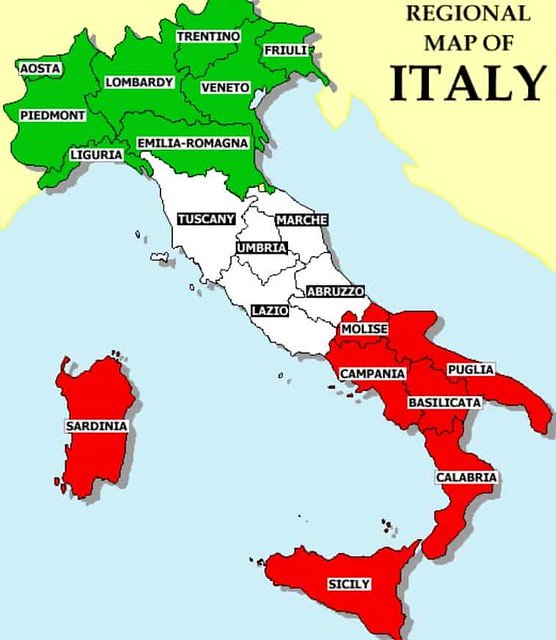Italy, a land of beauty, history, and diverse regions. What are the 20 states in Italy? The answer to this question unveils a colorful mosaic of unique territories. From the picturesque coast of Liguria to the majestic peaks of the Alps in Trentino-Alto Adige, each state offers its own charm and character. Let’s embark on a journey through the enchanting landscapes and rich cultures of Italy’s 20 states.
Exploring the 20 Regions of Italy: What You Need to Know
Italy, known for its rich history, stunning landscapes, and delicious cuisine, is a country that is divided into 20 unique regions, each with its own distinct characteristics and charm. Let’s take a journey through the diverse states of Italy and uncover what makes each one special.
The Regions of Italy: An Overview
Italy is divided into 20 regions, which are further divided into provinces. Each region has its own regional government and varying degrees of autonomy. From bustling cities to picturesque countryside, Italy offers a wide range of experiences for both locals and visitors.
Northern Regions
1. **Lombardy** – Located in the north of Italy, Lombardy is known for its vibrant fashion capital, Milan, as well as the stunning Lake Como.
2. **Veneto** – Home to the romantic city of Venice, Veneto is famous for its canals, gondolas, and historic architecture.
3. **Piedmont** – Known for its Baroque buildings and the delicious cuisine of Turin, Piedmont is a region rich in history and culture.
4. **Emilia-Romagna** – A culinary paradise, Emilia-Romagna is famous for its pasta, cheese, and balsamic vinegar.
Central Regions
5. **Tuscany** – Tuscany is synonymous with rolling hills, vineyards, and charming medieval towns like Florence and Siena.
6. **Lazio** – Home to the capital city of Rome, Lazio is a region steeped in ancient history and modern elegance.
7. **Umbria** – Known as the “Green Heart of Italy,” Umbria is a region of lush landscapes, historic hilltop towns, and delicious cuisine.
8. **Marche** – Marche is a region of stunning coastline, medieval villages, and vibrant cultural heritage.
Southern Regions
9. **Campania** – Campania is home to the ancient city of Pompeii, the stunning Amalfi Coast, and the vibrant city of Naples.
10. **Apulia** – Located in the heel of Italy’s “boot,” Apulia boasts whitewashed villages, crystal-clear waters, and unique trulli houses.
11. **Calabria** – Calabria, known for its rugged mountains and pristine beaches, is a region of natural beauty and traditional cuisine.
12. **Sicily** – The largest island in the Mediterranean, Sicily is a melting pot of cultures, flavors, and landscapes, with attractions like Mount Etna and the Valley of the Temples.
Island Regions
13. **Sardinia** – Sardinia is a paradise for beach lovers, with its crystal-clear waters, sandy beaches, and rugged coastline.
Exploring the Lesser-Known Regions
While regions like Tuscany and Sicily are popular among tourists, Italy is also home to some lesser-known regions that are worth exploring.
Valle d’Aosta
Valle d’Aosta is a small region nestled in the Alps, known for its picturesque landscapes, charming villages, and excellent skiing opportunities.
Molise
Molise is one of Italy’s smallest regions, but it packs a punch with its unspoiled nature, historic towns, and delicious cuisine.
Friuli-Venezia Giulia
Located in the northeastern part of Italy, Friuli-Venezia Giulia is known for its diverse cultural influences, stunning mountains, and delicious seafood.
Basilicata
Basilicata, located in the instep of Italy’s “boot,” is a region of rugged landscapes, ancient cave dwellings, and delicious regional dishes.
Italy’s 20 regions offer a diverse tapestry of landscapes, cultures, and experiences, making it a country that truly has something for everyone. Whether you’re exploring the iconic sights of Rome or discovering the hidden gems of Molise, Italy’s regions are sure to captivate and inspire. So, pack your bags and get ready to embark on a journey through the enchanting states of Italy. Buon viaggio!
All 20 Italian Regions Stereotypes Explained
Frequently Asked Questions
Which 20 states make up Italy?
Italy is divided into 20 regions, not states. The regions of Italy are: Abruzzo, Basilicata, Calabria, Campania, Emilia-Romagna, Friuli Venezia Giulia, Lazio, Liguria, Lombardia, Marche, Molise, Piemonte, Puglia, Sardegna, Sicilia, Toscana, Trentino-Alto Adige, Umbria, Valle d’Aosta, and Veneto.
What are the names of the regions in Italy?
The regions of Italy include: Abruzzo, Basilicata, Calabria, Campania, Emilia-Romagna, Friuli Venezia Giulia, Lazio, Liguria, Lombardia, Marche, Molise, Piemonte, Puglia, Sardegna, Sicilia, Toscana, Trentino-Alto Adige, Umbria, Valle d’Aosta, and Veneto.
How many regions are in Italy?
Italy is composed of 20 regions, each with its own unique culture, history, and landscape. These regions play a significant role in Italy’s administrative structure and governance.
Final Thoughts
In conclusion, Italy is divided into 20 regions, each with its own unique culture and history. These regions, often referred to as states in Italy, include popular destinations such as Tuscany, Sicily, and Veneto. From the northern region of Lombardy to the southern region of Calabria, each state offers a distinct experience for visitors. Understanding what are the 20 states in Italy can help you plan your travels and immerse yourself in the diversity of this beautiful country.




